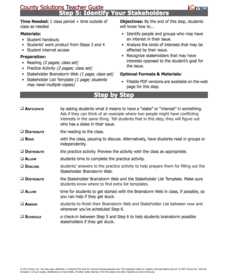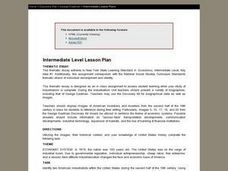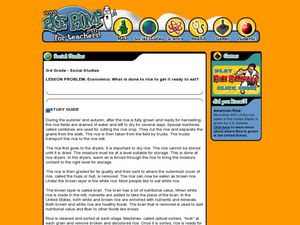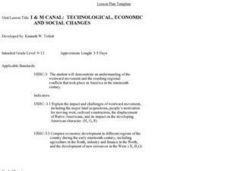Council for Economic Education
Banks and Credit Unions (Part 1)
Imagine you have money you want to save ... where do you put it? Pupils investigate the similarities and differences of banks and credit unions as they determine where exactly to place their hard-earned money. Through a WebQuest, they...
Council for Economic Education
Sand Art Brownies
Which is better, Coke or Pepsi? Pupils analyze the concept of substitute goods as they investigate the choice to purchase alternate products for better prices. Fun and practical, the engaging shopping exercise helps savvy scholars get...
Council for Economic Education
Understanding a Balance Sheet
Read any financial website or book, and it is bound to discuss the words asset and liability. But what do these words actually mean to the class? The resource effectively explains by using multiple formats and techniques, including...
Carolina K-12
Battle Behind the Pumps
After considering the role that gasoline plays in our lives and our dependence on it as a society, learners participate in a reading activity discussing why oil prices are increasing. They will then simulate being members of a committee...
iCivics
Step 5: Identify Your Stakeholders
Have you ever had a goal, but needed help achieving it? Scholars analyze the purpose of stakeholders in the fifth installment of a 10-part County Solutions - High School series. They investigate finances, personal concerns, geography,...
iCivics
Step 6: Plan Your Attack
Lights, camera, ACTION! Pupils learn what it takes to set up an action plan to achieve a goal in the sixth installment of a 10-part County Solutions - High School series. They research, analyze, and work together to create a plan of...
iCivics
Step 7: Fill the Holes
It's time to communicate without using emojis or hashtags! In the seventh step of a 10-part County Solutions - High School unit scholars analyze professional communication when accomplishing a goal. They use examples, research, and data...
iCivics
Step 8: Talk It Up
You have 30 seconds to sell your idea ... go! Scholars master the art of the elevator pitch in the eighth step of a 10-part series. They use research, practice, and step-by-step planning to gain a better understanding of the method....
iCivics
Step 9: Grab People’s Attention
Attention! Attention! Scholars investigate the concept of attention-grabbers in advertising a product or a cause. They use the ninth installment of a 10-part County Solutions - High School series to analyze t-shirts, bumper stickers,...
iCivics
Step 10: Make Your Pitch
Step right up! The final installment of a 10-part series has scholars make their sales pitch to the class. They complete final templates to help put their project presentations together. Incorporating all of the strategies and ideas of...
Curated OER
Introduction to Business: Business Feud
Trying to liven up an introductory economics unit on wants and needs? Combine text review with a game using this guide, which has scholars earning the right to play "Business Feud" by scoring high on reading recall questions. While it is...
Curated OER
ECONOMIC SYSTEM
High schoolers identify two American industrialists within the United States during the second half of the 19th century. They use specific examples, compare and contrast how these two industrialists were successful in their market. ...
Curated OER
The Social Effects of the Great Depression
Students explore U.S. history by listening to an economics lecture. In this Great Depression lesson plan, students read a letter written to the President during the worst economical disaster in U.S. history. Students answer study...
Curated OER
social studies: Life in Colonial America
Students explore the trials and tribulations early colonial life and note its successes. Through literature, Internet research, and interactive software, they engage in various activities to evaluate early social and cultural development.
Curated OER
Social, Political and Economic Effects of Industrialization
Tenth graders role-play a person living in the United States during the 1890s. Students research their role using focus questions about daily life, including standard of living.industrialization. They have the opportunity to ...
Curated OER
Social and Cultural Issues in the Civil Rights Movement
Learners watch videos, listen to speeches and analyze the information that is presented about the civil rights movement. They examine visual art of the period.
Curated OER
Economics: What is done to rice to get it ready to eat?
Third graders create a map showing the journey of rice from the field to the grocery store. For this agriculture lesson, 3rd graders discover and map the process of harvesting and preparing rice to be packaged and shipped to sell to...
Curated OER
Social Studies: Global Women and Poverty
Students conduct research and make comparisons about various global economies. Create graphic organizers to present their research findings and illustrate solutions to problems. Students discuss and debate issues based on what they have...
Curated OER
I & M Canal: Technological, Economic
Students read about and discuss the reasons European countries were interested in the Ohio Valley. They complete a puzzle to review vocabulary and watch a video on the Illinois Prairie and the I & M Canal. They rewrite the historical...
Curated OER
Examine Economic Factors That Influence Human Migration Along the U.S/Mexican Border
Students bring in their own article about immigration and how it is affecting their community. They summarize their article and brainstorm reasons why someone would immigrate to another country. They discuss push and pull factors.
Curated OER
Geography of the Study of the Spanish-speaking People of Texas
Students identify the physical features, demographic characteristics, and history of the four Texas towns featured in Russell Lee's photo essay, "The Spanish-Speaking People of Texas." They conduct Internet research, and create a travel...
Curated OER
HISTORICAL AND SOCIAL SCIENCES ANALYSIS
Young scholars examine a variety of maps and documents to identify physical and cultural features of neighborhoods, cities, states, and countries, to explain the historical migration of people, expansion and disintegration of empires,...
Curated OER
Migration and Immigration in the United States: Three Case Studies
Students examine the early migration of Native Americans, African Americans, and the British Colonists. They conduct Internet research, complete a timeline, label maps, compare/contrast the three groups' experiences, and write an essay.
Curated OER
A Day in the Life: Studying Ancient Rome
Class members use their knowledge of Ancient Rome to write articles for an online newspaper. Using WebBlender, learners craft articles that feature Roman politics, culture, and leisure activities.

























